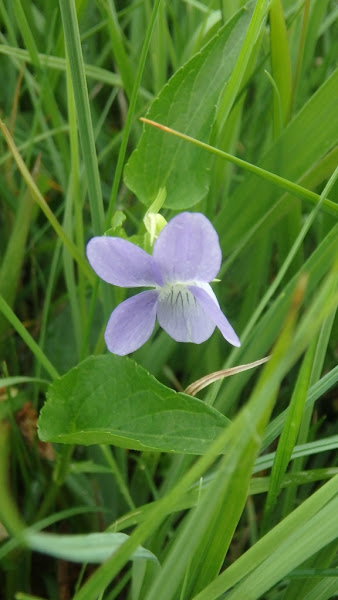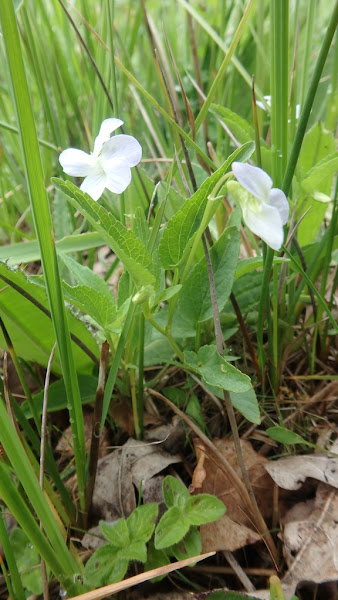
The hybrid Viola x ritschliana between the nationally rare and critically endangered fen violet and the locally rare heath dog violet.
Otmoor Site of Special Scientific Interest was the venue for my latest recording meeting, held on bank holiday Monday. The area has been thoroughly botanised over the last few years so the purpose of the meeting was largely to have fun and see one of the finest wet grassland sites in the country, but I had hoped to add a few records. We were joined by members of the Reading and District Natural History Society. I didn't count but with Oxfordshire Flora Group regulars we made up an exceptionally large group (whom I kept waiting for twenty minutes when I mis-remembered the start time!).
I know the Moor well but this was only the second occasion I'd had to access the area around the MoD firing range. There are many wonderful things in there and for these we made a bee-line. As much as I enjoy recording meetings it was refreshing just to be able to walk somewhere with botanists without getting mired in recording all the plants one sees on the way!
Within the range the first species of interest was a weed, which I over-enthusiastically misidentified as the umbellifer Torilis arvensis (spreading hedge-parsley) on account of its hooked fruits. This is an endangered plant, severely declined in Oxon, and everyone got rather excited. Subsequent to the meeting I re-examined the plant and realised that it was instead Anthriscus caucalis (bur chervil), which also has hooked fruits. We all get things wrong sometimes, but this is still an interesting record! While not threatened A. caucalis has very few Oxon records, most of them old.
The author holding Anthriscus caucalis and looking pleased with himself despite being wrong
Several hours were spent botanising the main meadow within the range, much of it to the accompaniment of a pair of purring turtle doves. On my previous visit the grassland had been deep blue-purple with the massed flowers of Succisa pratensis (devil's-bit scabious), and on Monday it was purple-pink with those of Cirsium dissectum (meadow thistle). The latter is just one of the many species here indicative of nutrient-poor ancient grassland, and indeed the shortness of the vegetation was quite remarkable for a meadow. Within the very finely textured sedge- and forb-rich sward were such esoteric delights as Carex hostiana (tawny sedge), Carex pulicaris (flea sedge), the nationally rare C. filiformis (downy-fruited sedge) and Festuca filiformis (fine-leaved sheep's fescue) at its only Oxon site, and many colourful crowd-pleasers such as Dactylorhiza maculata (heath spotted orchid), Genista tinctoria (dyers' greenweed), Silaum silaus (pepper saxifrage), and the Otmoor speciality, the extremely rare, critically endangered and legally protected Viola persicifolia (fen violet), as well as Viola canina subsp. canina (heath dog violet) and the hybrid between the two V. x ritschliana.

|
Cirsium dissectum , the range
|

Ranunculus peltatus with its big flowers and laminar aerial leaves. We also found the smaller-flowered R. trichophyllus with separated petals and a U-shaped nectary pit. Both these water crowfoot species are very local in Oxfordshire.
After lunch we walked north from the firing range into the expanse of species-poor pasture that
forms most of the SSSI. Accompanied now by bubbling curlew and redshank, and bumping into a wader-clad Jeremy
Biggs and Penny Williams of the Freshwater Habitats
Trust, we explored the aquatic habitat of the ancient Fowl's Pill and the New Pill. The
former is not as rich as it once was but Apium inundatum (lesser marshwort) was seen in
its only Oxon locality, as well as a little of Utricularia vulgaris (bladderwort). The new
Pill is richer with an abundance of Baldellia ranunculoides (lesser water plantain), which
grows only at Otmoor in the county. Water crowfoots were putting on a show with both
Ranunculus peltatus (pond water crowfoot) and R. trichophyllus (thread-leaved water
crowfoot) in flower. Neither pond was very good for stoneworts (charophytes) being too vegetated, but I did
find a very small amount of Chara aspera and C. globularis growing on one of the
few patches of exposed subtrate.
The meeting was certainly a great success with many attendants encountering species they hadn't seen before — Carex filiformis was new to me — and everyone came away with a sense of the richness of Otmoor. Both the SSSI and the wider area, including the RSPB reserve, are certainly unique, and one could compose several blog posts about the Moor and still fail to do it do justice by a long way. My experience of Otmoor is of a landscape so rich, so astonishingly intact, that it is really quite easy to forget that a lot of the Moor's most charismatic wildlife has been decimated country-wide. I let the selection of photographs from this meeting and my wanderings speak for themselves.
The meeting was certainly a great success with many attendants encountering species they hadn't seen before — Carex filiformis was new to me — and everyone came away with a sense of the richness of Otmoor. Both the SSSI and the wider area, including the RSPB reserve, are certainly unique, and one could compose several blog posts about the Moor and still fail to do it do justice by a long way. My experience of Otmoor is of a landscape so rich, so astonishingly intact, that it is really quite easy to forget that a lot of the Moor's most charismatic wildlife has been decimated country-wide. I let the selection of photographs from this meeting and my wanderings speak for themselves.
















No comments:
Post a Comment